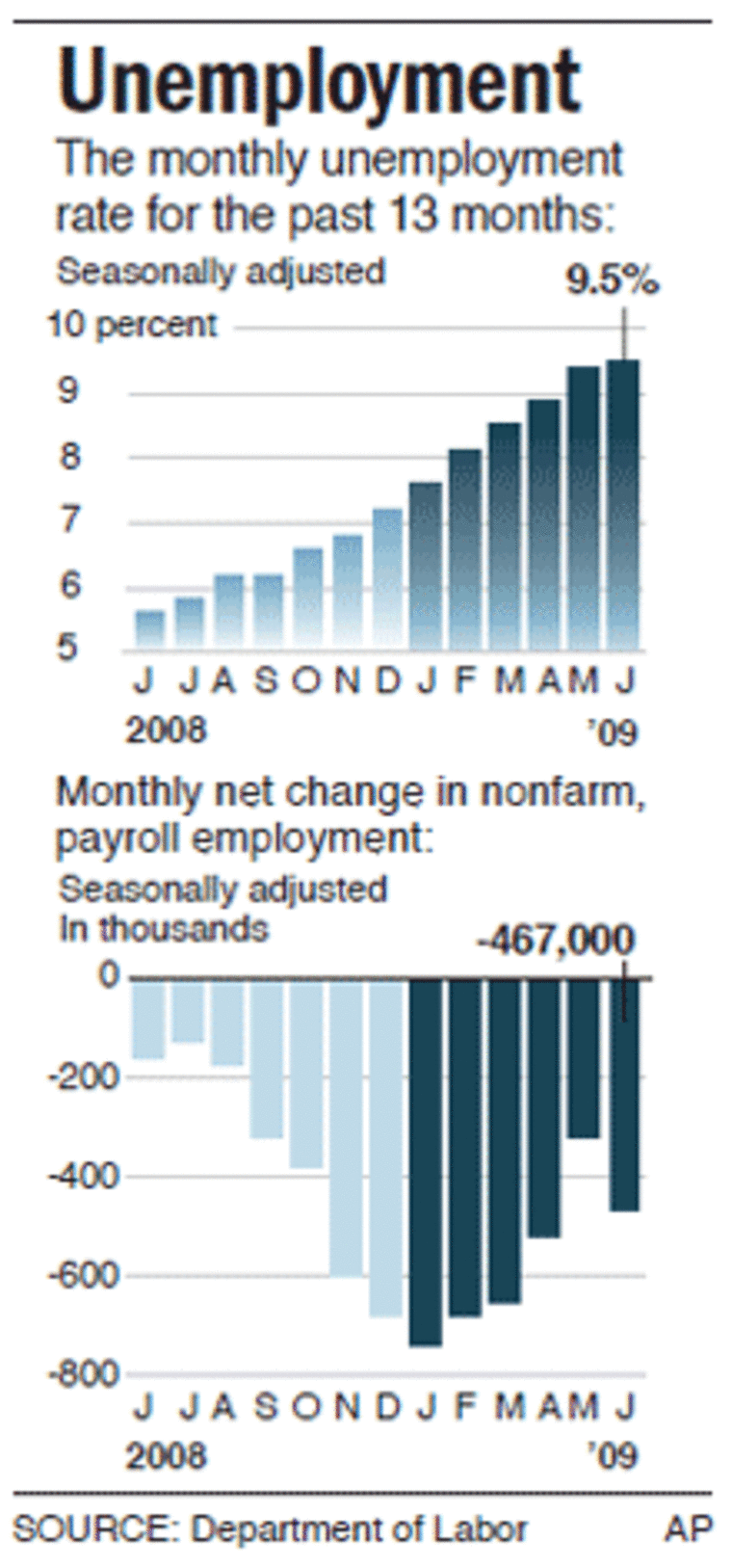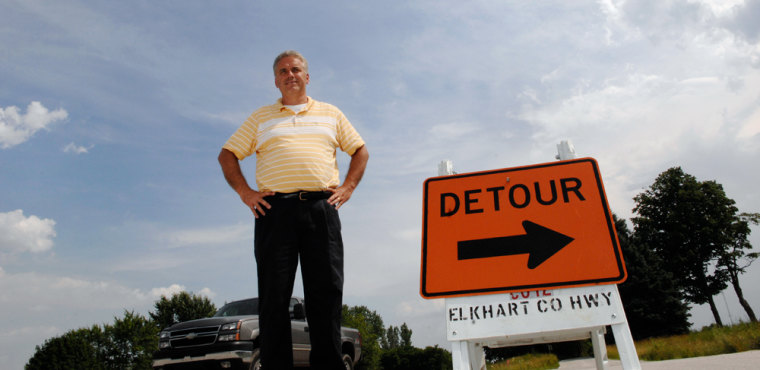Sometimes the "shovel-ready" roads from the government's economic stimulus program lead straight to a pile of paperwork but not to the jobs they were supposed to create.
To find out how well increased federal spending is flowing through the economy, take a drive down Country Road 17 in Elkhart, Ind.
Traffic along this major thoroughfare heads south from the Interstate, bypasses downtown and then stops dead just outside of Goshen, the next town over. The plan to extend the road is approved and ready to go to bid within 60 days, according to county highway manager Jeff Taylor.
But instead of digging new bridge foundations, Taylor said his department is digging through a deluge of government forms.
“I’ve got an engineer full time and that’s just about all he’s doing is red tape every day — filling out forms, filling out forms,” he said. “You will not see stimulus used until next year because this year is going to be all red tape."

An approval process that usually takes his department five steps has now stretched to 50, Taylor said. Rights of way that have already been acquired, for example, have to be reviewed and re-approved.
“They’ve made it so rigorous that when you say ‘shovel ready,’ the lay person sitting at the bar having his beer wishing he could get back to work is thinking ‘Why don’t we get busy?,’” Taylor said. “And I’m telling you we’re not going to get busy any time soon because it takes a long, long time to get through the paperwork.”
Taylor is among thousands of front-line managers overseeing the planning and design of billions of dollars worth of projects that were supposed to get a jump-start from the $787 billion stimulus package enacted in February. The boost in spending was, in turn, supposed to help reverse the collapse in the economy and create new jobs.
So far, it doesn't seem to be working out that way. Though the rise in unemployment has slowed somewhat since the stimulus was enacted, the Obama administration concedes that job losses may not ease for some time, even with massive government spending designed to create new ones.
"How employment numbers are going to respond is not yet clear," President Barack Obama said earlier this week before heading to Michigan, where the unemployment rate is among the highest in the country. "My expectation is that we will probably continue to see unemployment tick up for several months."
Defenders of the stimulus package note that without the huge government response, the unemployment rate would be even higher. They also note that the loss of trillions of dollars in household wealth and the huge pile of bad debts choking the banking system have created an economic mess unlike any other economic downturn in memory.
“We are in a balance sheet recession,” said Laura Tyson, a former head of the Council of Economic Advisers during the Clinton Administration who is now one of President Obama's economic advisors. “We haven't gone through this kind of recession in most of the lifetimes of the forecasters. By the way, the models that forecasters use are the same models that missed the fact that we were going to have this recession. So let's admit a lot of uncertainty here.”
When Congress and the White House put together a plan to spend $787 billion to try to rescue the U.S. economy, they agreed to spread the flow of money over several years. According to the Congressional Budget Office, some $185 billion is targeted to be spent this year, roughly $400 billion next year, $135 billion in 2011 and the remainder in the following years.
Critics of the package say that it’s not surprising that the huge war chest seems to be having a limited impact.
“I think it's doing exactly what everyone predicted it would do,” said Lawrence Lindsey, a private economist and senior economic advisor in the Bush administration. “Every major budget analyst in both parties, and the Congressional Budget Office, said that this stimulus, the way it was constructed, wasn't timely, wasn't targeted on jobs and, therefore, wasn't going to stimulate the economy. And lo and behold, it didn't.”
So far, the bulk of the funds have been spent to fill the huge — and widening — holes in state budgets. The two biggest spending categories are for Medicaid and education. But that money is largely offsetting the collapse of revenues as falling house prices have eroded property taxes and rising unemployment have cut into income taxes.
Almost all 50 states are facing budget gaps for the upcoming fiscal year to the tune of about $166 billion, or 24 percent of all state spending, according to the Center on Budget and Policy Priorities. The group projects that by 2011 state budget shortfalls will top $350 billion — nearly half the entire stimulus package. Filling those state budget shortfalls with federal stimulus funds will help blunt deeper cuts in state jobs and services, but that money won’t help create new jobs.
“The stimulus wasn't going to turn this around overnight, but it's hard to argue that it's really in the pipeline and making a big difference right now,” said John Engler, the former governor of Michigan who is president of the National Association of Manufacturing.
When the stimulus plan was enacted the Obama administration predicted it would “save or create” 3.5 million jobs before 2011. Supporters of the plan argue that without it, the recession would have been deeper and job losses even greater. But the impact of the spending package is difficult to assess when the economy is still shedding jobs and the unemployment rate is rising.
“I don’t know how you measure job preservation,” said GOP Strategist Terry Holt. “The American people are going to judge this president and this economy based on whether or not they can create jobs. As long as this economy isn't creating jobs, the political weight will get heavier on this administration with every passing month.”
Since the recession began in December 2007, the economy has shed more than 6 million jobs, including 467,000 in June. During the peak jobs market of this decade, in 2005, the economy was creating about 200,000 jobs a month; about 125,000 new jobs are needed every month just to keep up with the growth of the work force.
So even once the economy begins creating new jobs again, it could be several years before the millions of workers laid off during the recession re-enter the job market and the unemployment rate begins falling to more normal levels.
Continued job losses also are weighing more heavily on the economy as lost wages cut deeper into consumer spending, which accounts for roughly two-thirds of the U.S. economy. If federal spending doesn’t flow quickly enough to offset the drop in personal income, sluggish consumer spending will remain a drag on growth for some time.
Consumer spending has also been depressed by the collapse of the housing market and huge losses in savings. That’s forced many households to tighten their belts; massive federal spending by itself will do little to get them back in a spending mood.
“Baby boomers feel like they lost 35 percent of their net worth in one year, and they don't feel like they’ve got as much time as they head into their retirement years,” said Fred Crawford, CEO of the business consulting firm Alix Partners. “So they are doubling down on savings. We are expecting the savings rate — which was just a year ago around zero percent and has now jumped to around seven percent — will probably approach 10 percent in the next couple of quarters. That’s is a big swing in spending.”
